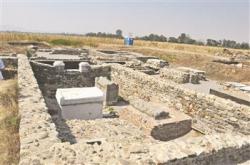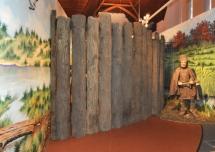INSTITUT SUPERIEUR D'ANTHROPOLOGIE
INSTITUTE OF ANTHROPOLOGY
ONLINE COURSES / COURS A DISTANCE
INSCRIPTION : Année Universitaire 2012/2013
REGISTRATION : Academic Year 2012 / 2013
KOSOVO -  Ulpiana - At an excavation site in Kosovo’s ancient city of Ulpiana, a team of Turkish archaeologists have discovered a baptistery dating from the Byzantine period. The archaeological team, consisting of archaeology students from Istanbul’s Mimar Sinan University and headed by Professor Haluk Çetinkaya, excavated in a 250 square-meter area, unearthing an important part of the sixth-century city.
Ulpiana - At an excavation site in Kosovo’s ancient city of Ulpiana, a team of Turkish archaeologists have discovered a baptistery dating from the Byzantine period. The archaeological team, consisting of archaeology students from Istanbul’s Mimar Sinan University and headed by Professor Haluk Çetinkaya, excavated in a 250 square-meter area, unearthing an important part of the sixth-century city.
http://www.hurriyetdailynews.com/turkish-archaeologists-reveal-6th-century-baptistery-abroad.aspx?pageID=238&nID=29535&NewsCatID=375
FRANCE – Metz - L’analyse au strontium : une précieuse méthode de contextualisation géographique. Le strontium est un élément chimique présent dans la plupart des roches. Au terme d’un long processus, il se retrouve dans le squelette humain. Appliquée au domaine de l’archéologie, l’analyse au strontium signe l’environnement naturel dans lequel a vécu un défunt, mis au jour lors d’une fouille. Elle peut également apporter des informations sur les déplacements de cette personne au sein d’un territoire. Le strontium de la « dame du Technopôle » . Les fouilles réalisées sur le site du Parc du Technopôle en 2009 ont mis au jour une sépulture féminine datée du Hallstatt final / La Tène A (fin du VIe-début du Ve siècle av. J.-C.). Les dents de la défunte ont été soumises à l’analyse au strontium. Le Dr Elisabeth Stephan, consultante au bureau Ostéologie de la Conservation du patrimoine et de l’archéologie du Bade-Würtemberg, à Konstanz en Allemagne, expliquera lors de la conférence, le contexte de découverte de cette tombe, les études réalisées et les résultats d’analyse au strontium, qui permettent d’en savoir plus sur la « dame du Technopôle ».
http://moselle.foxoo.com/video,conference-analyses-strontium-leur-contribution-l-archeologie-l-exemple-site-technopole,metz,nx12090713223020969.html
ROYAUME UNI – Mull - An archaeological dig aimed at linking the hidden secrets of an ancient Christian chapel site with St Columba, below, has been launched on the isle of Mull. Seven archaeologists, assisted by a 50-strong army of volunteers, are working on an intensive 28-day excavation at the seventh century chapel site. Dr Clare Ellis, who is leading the dig at Balisgate, near Tobermory, said clues had already emerged to suggest it had been a “daughter chapel”
of St Columba’s monastery on Iona. Dr Ellis, of Argyll Archaeology, said: “St Columba had a miracle cure, where he blessed white stones, and we have found white pebbles at the chapel leacht where a stone cross would have sat. “St Columba died in 597 and parts of a juvenile’s skull that was found here have been carbon dated to the 7th century AD, to 610-690, so there is a real possibility that this could have been a daughter chapel to Iona Abbey.”
http://www.scotsman.com/news/7th-century-chapel-dig-hopes-to-find-link-to-st-columba-on-isle-of-mull-1-2514287
USA –  Beaufort Inlet - The artifacts raised from the Queen Anne's Revenge shipwreck site in the coming weeks will be smaller in size but big in excitement. An eight-week dive expedition begins this week with final preparations for work in Beaufort Inlet at the wreckage of the ship considered to be the flagship of the infamous pirate Blackbeard. While divers with the N.C. Underwater Archaeology Branch – which is based at Fort Fisher – aren't planning to bring up any of the remaining cannons or anchors during this dive, they will be excavating from the forward hold area on the east side of the wreck site, which correlates to the lower portion of the ship. The QAR team is expecting to find ballast stones and smaller artifacts, but the excitement is in the unknown as it's a lesser explored area of the shipwreck.
Beaufort Inlet - The artifacts raised from the Queen Anne's Revenge shipwreck site in the coming weeks will be smaller in size but big in excitement. An eight-week dive expedition begins this week with final preparations for work in Beaufort Inlet at the wreckage of the ship considered to be the flagship of the infamous pirate Blackbeard. While divers with the N.C. Underwater Archaeology Branch – which is based at Fort Fisher – aren't planning to bring up any of the remaining cannons or anchors during this dive, they will be excavating from the forward hold area on the east side of the wreck site, which correlates to the lower portion of the ship. The QAR team is expecting to find ballast stones and smaller artifacts, but the excitement is in the unknown as it's a lesser explored area of the shipwreck.
http://www.starnewsonline.com/article/20120905/ARTICLES/120909854?Title=Queen-Anne-s-Revenge-dive-expedition-begins-this-week
ROYAUME UNI –  Holme Beach - The reasons why a unique timber circle was created by some of West Norfolk’s earliest inhabitants will be debated by the next generation. Seahenge lay hidden at Holme Beach for thousands of years until the sands shifted to reveal the circle in 1998. Archaeologists have been debating why early Bronze Age builders constructed the 55 oak posts around an upturned tree stump. It is believed that Seahenge could be a ceremonial monument in which the bones of a Bronze Age VIP would have been placed to “weather” before being buried elsewhere. An AQA spokesman said: “The Bronze Age circle at Holme-next-the-Sea is one of a number of important sites of interest to archaeologists included in one of the AS Archaeology units. “We are particularly interested in what can be inferred about the beliefs of Bronze Age people from studying this site. It was introduced to the specification this year (2012) and will feature until 2014.” Some of the preserved timbers are on display in Lynn Museum.
Holme Beach - The reasons why a unique timber circle was created by some of West Norfolk’s earliest inhabitants will be debated by the next generation. Seahenge lay hidden at Holme Beach for thousands of years until the sands shifted to reveal the circle in 1998. Archaeologists have been debating why early Bronze Age builders constructed the 55 oak posts around an upturned tree stump. It is believed that Seahenge could be a ceremonial monument in which the bones of a Bronze Age VIP would have been placed to “weather” before being buried elsewhere. An AQA spokesman said: “The Bronze Age circle at Holme-next-the-Sea is one of a number of important sites of interest to archaeologists included in one of the AS Archaeology units. “We are particularly interested in what can be inferred about the beliefs of Bronze Age people from studying this site. It was introduced to the specification this year (2012) and will feature until 2014.” Some of the preserved timbers are on display in Lynn Museum.
http://www.lynnnews.co.uk/lifestyle/lifestyle-and-leisure-news/bronze-age-monument-discovered-on-west-norfolk-beach-is-included-in-the-latest-a-level-syllabus-1-4217259